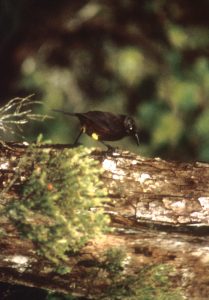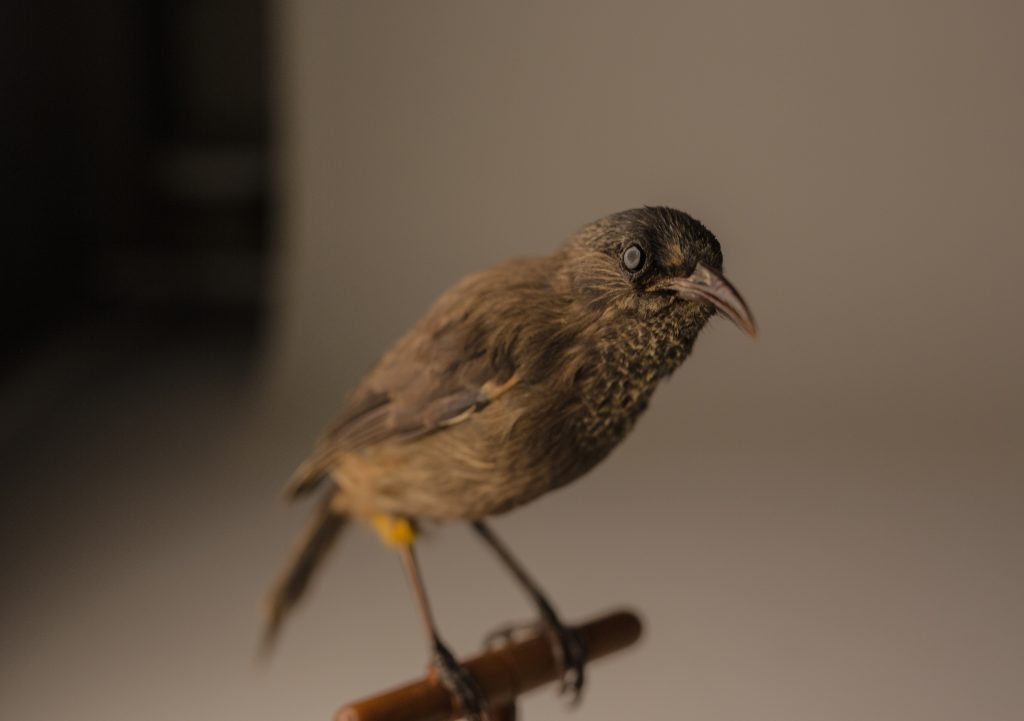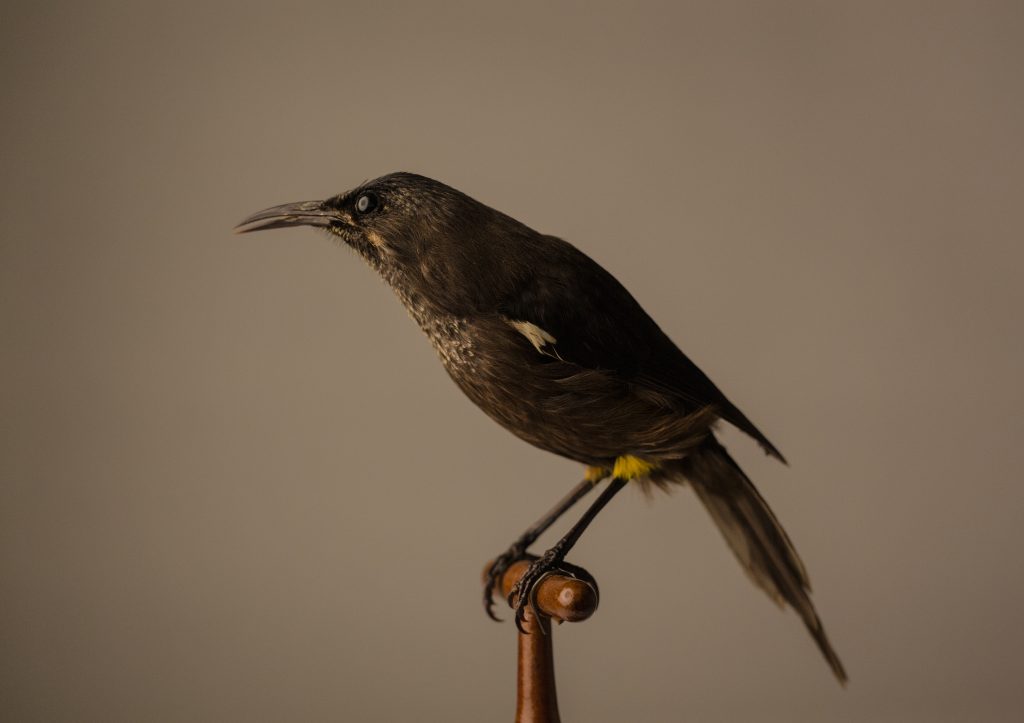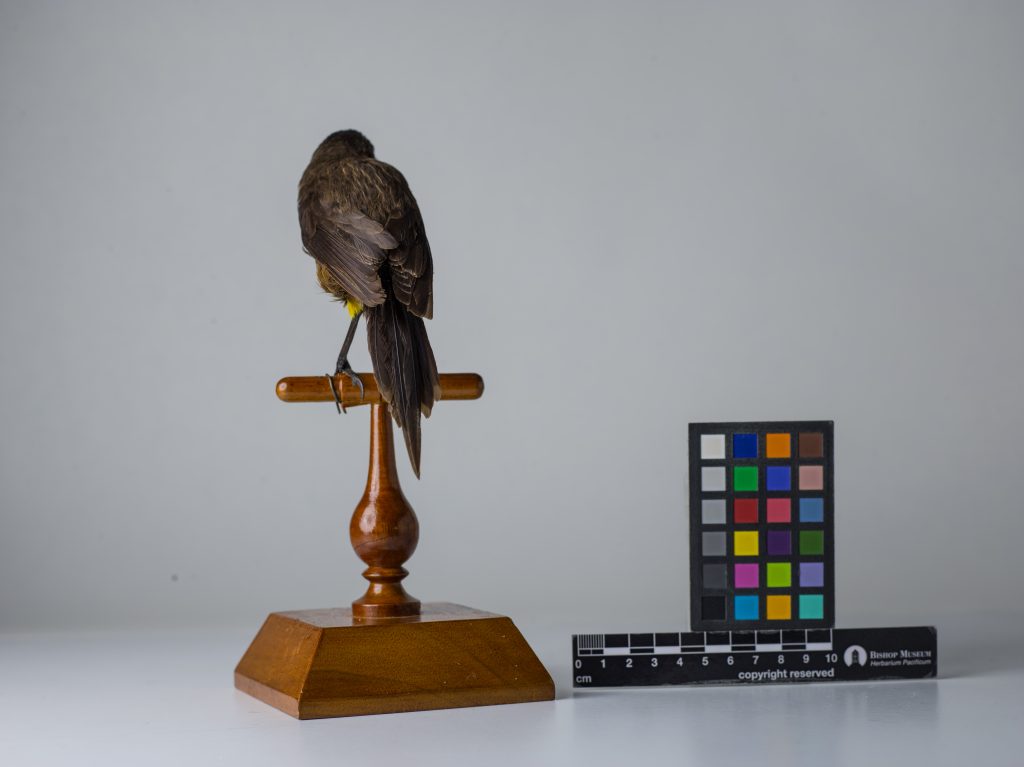Kauaʻi ʻōʻō
Names
- ʻŌlelo Hawaiʻi: Kaua‘i ‘ō ‘ō
- Scientific: Moho braccatus
Conservation Status
- Presumed Extinct
- Federally Listed as Endangered
- State Listed as Endangered
- State Recognized as Endemic
- NatureServe Heritage Rank GH—Possibly Extinct
- IUCN Red List Ranking—Extinct
- Revised Recovery Plan for Hawaiian Forest Birds—USFWS 2006
Species Information

Kauaʻi ʻōʻō. PC: Mark Collins
Endemic to its namesake, the Kaua‘i ‘ō‘ō is the smallest of the five known species of Hawaiian honeyeaters (Family: Meliphagidae), and has the least showy plumage of the four Hawaiian species of Moho. ‘Ō‘ō eat a variety of arthropods, snails, ‘ōlapa (Cheirodendron spp.) fruits, and nectar from the flowers of ‘ōhi‘a (Metrosideros polymorpha), lobelia, as well as other species. Early naturalists reported the species extensively feeding on the flower bracts of ‘ie‘ie (Freycinetia arborea), a species abundant in lowland forests, but not in upper elevation forests. Little is known about the species’ breeding biology. The only known nests were in cavities in large ‘ōhi‘a snags.
Distribution
Unknown. Possibly extinct. Was last observed in stream valleys of the central Alaka‘i Wilderness Preserve. Historically, the Kaua‘i ‘ō‘ō occurred in forest habitat throughout the island.
Habitat
Unknown. The last sightings were in dense ‘ōhi‘a forests of the Alaka‘i swamp. Ironically, this habitat may have been low-quality or marginal habitat. ‘Ie‘ie, an important food plant, common in the lower elevation forests previously occupied by ‘ō‘ō, is not found in the upper elevations forests where the species was last observed. Extensive damage to forests by hurricanes in 1982 and 1992 may have further reduced the suitability of high-elevation forests, especially given the species’ apparent dependence on large snags for nest sites. The area where the species was last observed is managed by the State of Hawai‘i as a Wilderness Preserve.
Threats
Unknown. However, the species was likely susceptible to the same factors that threaten other native Hawaiian forest birds, including loss and degradation of habitat, predation by introduced mammals, and disease. For Kaua‘i ‘ō‘ō, the following likely were of particular concern:
- Disease. The precipitous decline of all Hawaiian Moho species suggests that disease played a role in this species’ decline.
- Hunting. Although other ‘ō‘ō species were historically exploited by Native Hawaiians for their feathers, the role this activity played in the decline of the Kaua‘i ‘ō‘ō is equivocal, but likely minimal given the species’ plumage.
Photos
Additional Resources
For more information and references visit the DLNR State Wildlife Action Plan factsheets. DOFAWʻs species pages and State Wildlife Action Plan fact sheets are provided for general information and are not meant to be a citable, original source of data. If you are a student, researcher, or writer looking for a citable source, please explore the references below or find other original data sources, rather than citing these webpages. The references below were provided by the authors of the State Wildlife Action Plan fact sheets at the time of drafting:
- Foster JT, Tweed EJ, Camp RJ, Woodworth BL, Adler CD, Telfer T. 2004. Long-term population changes of native and introduced birds in the Alaka‘i swamp, Kaua‘i. Conservation Biology 18:716-725.
- IUCN Red List of Threatened Species. 2015. Version 2014.3. Available at: www.iucnredlist.org. (Accessed May 2015).
- Scott JM, Mountainspring S, Ramsey FL, Kepler CB. 1986. Forest bird communities of the Hawaiian islands: their dynamics, ecology and conservation. Lawrence, (KS): Cooper Ornithological Society.
- Sykes PW, Kepler AK, Kepler CB, Scott JM. 2000. Kaua‘i o‘o (Moho braccatus), O‘ahu ‘o‘o (Moho apicalis), Bishop’s ‘o‘o (Moho bishopi), Hawai‘i ‘o‘o (Moho nobilis), and kioea (Chaetoptila angustipluma). In The Birds of North America, No. 535 (Poole A, Gill F, editors.). Philadelphia, (PA): The Academy of Natural Sciences; and Washington DC: The American Ornithologists’ Union.
- U.S. Fish and Wildlife Service. 2006. Revised Recovery Plan for Hawaiian Forest Birds. Portland, (OR): U.S. Fish and Wildlife Service.






